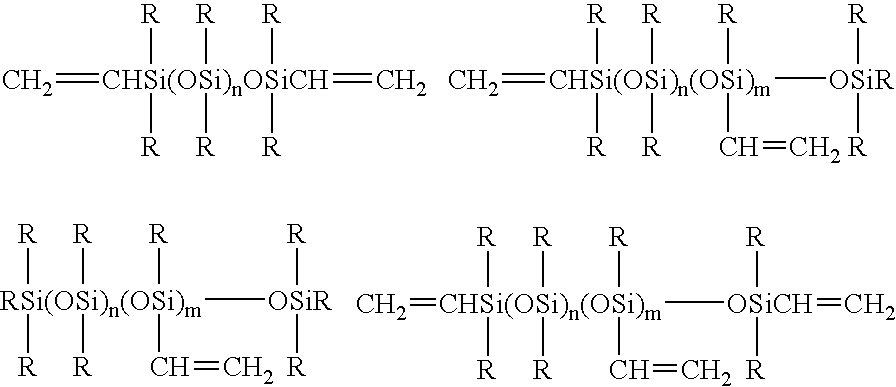Silicone rubber composition for the tire production and a method of producing the same
- Summary
- Abstract
- Description
- Claims
- Application Information
AI Technical Summary
Benefits of technology
Problems solved by technology
Method used
Image
Examples
preparation example 1
Preparation of Compound
[0048] In a kneader are mixed 100 parts of straight-chain dimethylpoly-siloxane encapsulated at both ends of its molecular chain with dimethylvinylsiloxy group and comprising repetitive dimethylsiloxane units as a main chain and having a weight average molecular weight of 16000 (vinyl group content=0.2 wt %), 40 parts of fumed silica (specific surface area through BET method: 200 m2 / g, tap density: 0.2 g / ml), 5 parts of hexamethyl disilazane and 2.5 parts of water at room temperature for 1 hour. Then, the temperature inside the kneader is raised up to 160° C. over 1 hour and then the mixing is continued for 4 hours while keeping this temperature to obtain a compound (1).
preparation example 2
Preparation of Crosslinking Agent
[0049] A crosslinking agent (1) is obtained by mixing 7 parts of the same dimethylpolysiloxane encapsulated at both ends of its molecular chain with dimethylvinylsiloxy group having the weight average molecular weight of 16000 as in Preparation Example 1 (vinyl group content=0.2 wt %) with 3 parts of methylhydrogen polysiloxane encapsulated at both ends of its molecular chain with trimethylsiloxy group having a viscosity of 30 cP (content of hydrogen atom as Si—H bond=1.5 wt %).
preparation example 3
Preparation of Curing Catalyst
[0050] A curing catalyst (1) is prepared by uniformly mixing 3 parts of a catalyst finely pulverized by dispersing a vinylsiloxane complex of chloroplatinic acid into a thermoplastic silicone resin having a softening point of 80-90° C. (corresponding to 30 ppm as a conversion by weight of platinum metal to total amount of components (A), (B) and (D) in the compounding composition of each of the examples and comparative examples) with 7 parts of dimethylpolysiloxane encapsulated at both ends of its molecular chain with dimethylvinylsiloxy group and having a weight average molecular weight of 13000 (vinyl group content=0.21 wt %).
PUM
| Property | Measurement | Unit |
|---|---|---|
| Fraction | aaaaa | aaaaa |
| Percent by mass | aaaaa | aaaaa |
| Percent by mass | aaaaa | aaaaa |
Abstract
Description
Claims
Application Information
 Login to View More
Login to View More - R&D
- Intellectual Property
- Life Sciences
- Materials
- Tech Scout
- Unparalleled Data Quality
- Higher Quality Content
- 60% Fewer Hallucinations
Browse by: Latest US Patents, China's latest patents, Technical Efficacy Thesaurus, Application Domain, Technology Topic, Popular Technical Reports.
© 2025 PatSnap. All rights reserved.Legal|Privacy policy|Modern Slavery Act Transparency Statement|Sitemap|About US| Contact US: help@patsnap.com

